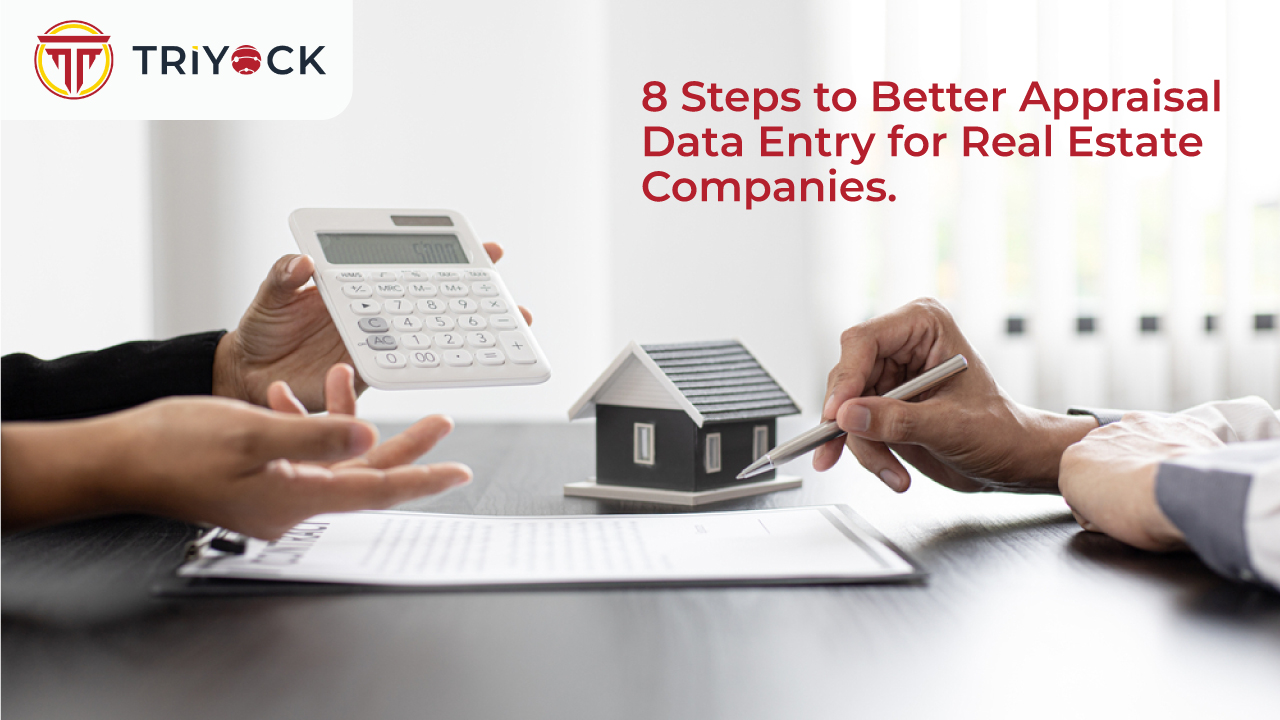
8 Steps to Better Appraisal Data Entry for Real Estate Companies
Shivam Shekhawat
Introduction
Accurate appraisal data entry is crucial for real estate companies because it forms the foundation of their business operations. Real estate companies rely on accurate appraisal data to make informed decisions about property values, market trends, and investment opportunities. Inaccurate data can lead to incorrect valuations, which can result in financial losses for both the company and its clients.
Negative consequences of incorrect data entry
Incorrect data entry can have severe negative consequences for real estate companies few examples are given below:
- Inaccurate property valuations can result in overpricing or underpricing of properties. This can lead to lost sales and decreased revenue for the company.
- It can lead to legal issues and can result in costly legal battles that can damage the company's reputation as Real estate transactions involve a lot of legal documentation, and if any of the information is entered incorrectly, it can lead to disputes between buyers and sellers.
- Clients who receive incorrect information about properties or transactions may lose trust in the company and take their business elsewhere.
Most significantly, it may lead to a waste of time and money. It can slow down the process and lower production if workers have to spend time fixing errors or finding missing information.
Overall, real estate firms must make sure that their data input procedures are efficient and thoroughly reviewed for errors.
Step 1 Understanding the Assessment Process
For the purpose of determining the price of properties they are interested in purchasing or selling, real estate businesses significantly rely on the appraisal process. For these businesses to make wise judgments and steer clear of potential losses, understanding this process is essential.
What steps are taken throughout the evaluation process?
Throughout the assessment process, the property is extensively examined, including its location, size, condition, and other important aspects. Appraisers use various methods, such as comparing the property to nearby homes or looking at recent sales data, to arrive at a suitable valuation.
All laws regulating appraisals, such as those enforced by governmental entities or professional associations, must also be known by real estate enterprises. If these regulations are broken, fines or legal action may be taken.
Real estate firms should also collaborate closely with appraisers to guarantee that all relevant details are delivered and that any worries or issues are swiftly addressed. By working together, the parties can avoid misunderstandings and guarantee that the final valuation satisfies them both.
Key data points that need to be recorded accurately
- Details about the property: These include its dimensions, age, number of bedrooms and baths, lot size, and any special features or amenities.
- Location: The location of the property is important in establishing its value. The value of a property may vary depending on its location in relation to amenities like schools, retail malls, public transportation, and other facilities.
- Similar sales: To determine the fair market value of the property being evaluated, appraisers frequently use recent sales of nearby properties that are comparable to the one being valued.
- Condition: Another essential aspect in establishing a property's worth is the condition of the asset. The age and condition of the roof, the HVAC system, the plumbing and electrical systems, and other important elements of the house will all be taken into consideration by appraisers.
- Market trends: Appraisers will also take local market conditions into account, including home supply and demand as well as any influencing economic variables.
Step 2: Collecting Accurate Data
In order to produce reliable appraisals, it is crucial to be abreast of current developments and trends in the real estate markets. One of the biggest challenges in obtaining accurate data for assessment data input is making sure that all relevant information is gathered.
Making sure the data is current is another crucial factor to take into account while gathering reliable data for assessment data entry. This may involve going to the properties in person, searching through public records and other sources of information, and working with other suppliers in order to gather more information. It also necessitates paying great attention to every little detail and being committed to quality control throughout the entire process.
The importance of collecting accurate data
- Real estate organizations must gather correct data appraisal in order to make educated conclusions regarding the value of a property. This information is crucial for buyers, sellers, and investors who want to know the actual value of a property before making any deals.
- The market worth of a property, which is crucial in determining the suitable price for a property, may also be determined by real estate businesses with the aid of accurate data appraisal.
- Also, accurate data collection aids in the identification of market trends and the forecasting of future market circumstances by real estate companies. Making wise decisions regarding purchasing or selling homes requires the use of this knowledge.
- By giving them knowledge of what their rivals are doing, it also aids in keeping real estate companies competitive.
- Accurate data evaluation is additionally required for regulatory compliance. Real estate firms are required by a number of rules and regulations to conduct accurate property appraisals.
- Failing to comply with these regulations can result in legal penalties that can be costly and detrimental to the reputation of the company.
Tips for collecting accurate data
- Employ trustworthy sources: Obtaining accurate data for real estate evaluation calls for the use of trustworthy sources. This includes utilizing official documents like land titles, tax assessments, and zoning maps.
- Perform exhaustive inspections: In order to gather reliable data, it is important to conduct exhaustive inspections of the property. This entails inspecting the building's state, spotting any flaws or problems, and figuring out how much it is worth altogether.
- Take market trends into account: It's important to comprehend market trends when gathering information for real estate appraisal. This entails looking at recent sales of nearby houses that are comparable while taking into account elements like size, location, and amenities.
- Consider market conditions: Real estate markets are constantly changing, so it is important to consider current market conditions when collecting data for appraisal. Factors such as interest rates, supply and demand, and economic conditions can all impact property values.
- Use technology: Technology can be a valuable tool when collecting data for real estate appraisal. Online databases and software
Step 3: Organizing Data
One of the most important steps in evaluating a property's worth is organizing the data for the assessment of real estate. Several sorts of data, including as market trends, comparable sales, property attributes, and zoning laws, must be gathered and analyzed by appraisers. This data aids appraisers in creating a precise assessment of a property's value.
Organizing data for the appraisal of real estate requires a combination of technical expertise, analytical skills, and attention to detail.
The importance of organizing data for efficient data entry
Appraisers employ specialized software and databases that enable them to input and handle vast volumes of data fast in order to organize this data effectively. To guarantee the accuracy and objectivity of their evaluations, they also rely on their familiarity with the regional real estate markets and their comprehension of business practices.
Besides obtaining information, appraisers must also clearly and concisely convey their findings. Creating thorough reports describing the variables that affected their valuation and any assumptions or constraints they ran into during the appraisal process is required.
Tips for organizing data
1. Verify and compile the most recent lease data
The main necessity for marketplaces is lease data. Most real estate businesses require assistance gathering data on current renters and leases. They require it in order to provide their clients with the data needed to manage and keep tabs on lease agreements and tenants.
Important details include the length of the lease, the likelihood that the renters would renew it, and costs. They reveal information about the prospective earnings and, if any, hazards associated with a property. The following lease data fields are crucial:
- Renters' and owners' names.
- Describe the rental property.
- Tenancy duration.
- The cost of the rent.
- Fees and security deposits.
- Terms for upkeep and repairs.
- Contact details.
Data collection specialists were hired to gather pertinent property data from more than 1350 multiple listing services and appraisers each month. It was employed by a well-known US-based real estate property dealer to improve its property database and attract leads, prospects, and repeat customers.
2. Get details regarding the most recent tax assessment
The most current tax assessments for residential, business, and mixed-use properties are next. The amount of property income can vary from year to year. Also, it is essential to gather the most recent tax assessment data from the appropriate county websites. Marketplaces can assist buyers in gaining a comprehensive understanding of a property's value and tax obligations by providing accurate tax assessment data.
The number for the state-wide information system, SWIS: a distinctive six-digit identification number. The county is designated by the first two numbers, the city or town by the next two, and the village by the final two.
Percentage of market value set aside for evaluation Typically, a municipality will evaluate each
Property at the same proportion of market value. This must be stated, along with any deviations.
Date of valuation: A property's worth is determined by its market value as of the specified taxable status date.
Date of taxability: The owner and the property's physical state as of the assessment date
A number of the tax parcel: To apply for exemptions and assessment reviews, you had to provide the Section-Block-Lot, or SBL, number that matched the number on your tax bill.
Property location and class, land assessment, total assessment, complete market value, exemptions, tax descriptions, and comparable features are only a few other relevant data fields. You can supply your cherished consumers with real estate trends and property worth estimations by continuously monitoring changes to the tax data.
3. Assemble information on comparable homes
Real estate marketplaces like Zillow, realtor.com, trulia.com, foreclosure.com, apartments.com, etc. are considered to be the finest sources for similar homes by renters, buyers, sellers, and investors. This is due to the fact that the real estate data contained in these marketplaces is precise, thorough, and almost real-time.
Consumers can discover local information, and assess comparables in light of neighborhood patterns, the appreciation of house values, and price per square foot. Also, it provides them with a sense of the property's worth and how its dimensions, features, and location stacks up against those of comparable homes. The following equivalent property fields need to be gathered:
Location: Expand the search area to within a quarter-mile of the prospective customer's selected location. Add homes offered for sale or rent within the next 30 to 60 days.
Size: The property's specific size configurations. Add the number of bedrooms, baths, and living rooms in comparable residences. Add details on recent interior updates and upgrades to the property's condition
Age of Property: For the most realistic comparisons, use properties built around the same time. Walkability, commercial centers, waterfronts, views, public transportation, and schools are nearby amenities.
Per square foot cost: Consumers can find comparables by looking at pricing per square foot. Showcase the result of dividing the sale price of a property by its square footage.
Get information on comparable properties in the neighborhood from all available sources. This will enable your market to decide whether the asset you wish to include on your website will draw visitors.
Statistics or details regarding utility bills
Visitors to your real estate marketplace who are potential customers may want to look up information on utility bills to assess monthly costs. When gathering data on utility bills, check instances where some tenants pay utilities individually while others have them included in their lease. Get all data related to household typical utility costs.
Gas and electricity
water, sewage, and trash removal
telephone, cable TV, and the internet
Information on utility bills was gathered for one of the projects from the websites of the gas, electric, and water companies. To make sure that it matched the information supplied by the sellers, it was reviewed and verified. The information was additionally utilized to enhance the property details on one of the top real estate marketplaces.
Examine the seller’s tax return sections
Clients who are wanting to purchase real estate as an investment are more than eager to learn more about this portion of the tax return. If the seller has claimed any tax benefits for the property, they need to know about it. It's also a good idea to gather data on property deductions from the tax returns' "Schedule E" section. In the end, it assists your purchasers in confirming the veracity of a seller's representations regarding the property.
Compile lifestyle statistics with property data
Marketplaces must make an extra effort to meet their customers' needs for property data. In order to appeal to buyers and sellers from the next generation, facilities must be included. Customers' opinions on the following data are relevant in this regard:
Certain aspects of a property
Information On Storage
Dishwashers, Blenders, Refrigerators, Air Conditioners
Wi-Fi Connection
Washing And Drying Equipment
Security Alarms And Remote Locking Are Examples Of Smart Home Technologies.
Facilities And Community Amenities
Commercial Parcel Lockers
Fitness Centres With Gyms And Swimming Pools
A Place For Vehicles To Park
Amenities For Pets, Such As Pet Doors And Pet Zones
Protection Of The Region
It is crucial to gather correct data on lifestyle amenities. Take steps to ensure reliable information by confirming sources and the data's recentness. It will be convenient for you to keep your marketplace data organized, making it possible for your consumers to refer to it and identify patterns more quickly.
Step 4: Choosing the Right Data Entry Method
Using the appropriate data entry technique is essential when it comes to evaluation for real estate companies. It is necessary for the appraisal process to be accurate and effective. Manual data input, automatic data entry, and outsourcing data entry are just a few of the data entry techniques that are accessible.
The information must be manually entered into a system while using manual data entry. This approach takes a lot of time and is error-prone. It might, nevertheless, be appropriate for modest appraisals or in situations where there isn't any other choice.
Using software to automatically extract data from documents is known as automated data entry. When compared to manual data entry, this process is quicker and more precise. It can manage vast amounts of data and lowers the chance of errors.
When data entry is outsourced, a third-party business is hired to manage the assessment procedure. This approach has the potential to be economical and productive, but it necessitates careful supplier selection.
The scale of the assessment project, available funds, and degree of accuracy are just a few of the variables that must be taken into consideration while selecting the best data entry method.
Describe the various methods of data entry available and their pros and cons
In real estate organizations, there are a variety of data entry techniques accessible for appraisal. The most typical way is manual data input, where appraisers manually enter the data into a spreadsheet or database. Although this method is time-consuming and prone to mistakes, it is nevertheless extensively utilized.
The use of software to automatically extract data from numerous sources, including MLS listings, public records, and other databases, is another way. Although it takes an initial investment in software and training, this strategy saves time and minimizes errors.
Data entry outsourcing to a third-party service provider is the most recommended way. This choice involves careful consideration when choosing a trustworthy service provider, but it can be economical and successful.
Step 5: Validating Data
To guarantee that the information real estate companies give to their clients is correct and trustworthy, data validation is essential. Large amounts of data, such as property listings, market trends, and customer information, are handled by the real estate industry. Any inaccuracies or discrepancies in this data could have serious repercussions, including lost revenue or legal issues.
To effectively authenticate data, real estate organizations must adopt strong quality control methods. Among other things, this entails confirming the veracity of property specifics, like space footage and amenities, through on-site inspections and outside sources. Also, they ought to frequently update their databases with the most recent data on pricing and industry trends.
Real estate firms must also make sure that client data is safe and shielded from illegal access. To do this, stringent security measures must be put in place, and technologies for data encryption must be used.
Real estate organizations can improve their reputation for dependability and professionalism by routinely checking their data. By lowering errors and the likelihood of legal issues, they can also increase the effectiveness of their operating processes.
Provide tips for validating data
- Employ trustworthy sources: While validating their data, real estate organizations should always turn to trustworthy sources. Governmental data, MLS listings, and other reliable sources can be used in this.
- Verify accuracy: Before using the data, it's critical to verify its accuracy. Cross-referencing the data with data from other sources or utilizing tools that can spot mistakes are two ways to accomplish this.
- Confirm ownership: : It's crucial to confirm ownership while working with property data. You can do this by looking up public records or getting in touch with the property's owner.
- Assure completeness: Real estate organizations should make sure that their data sets contain all relevant information. This covers specifics like the size, location, and zoning information of the property.
- Update frequently: Data should be updated frequently because it can rapidly become out-of-date. A method for routinely updating data should be in place for real estate companies.Using Triyock analytics technologies can assist real estate organizations in validating their data and identifying
Step 6: Entering Data Accurately
Entering data accurately is crucial for real estate companies as it ensures that all information related to properties, clients, and transactions is correct and up-to-date. Accurate data entry helps in making informed decisions, avoiding errors, and maintaining a good reputation in the industry.
Here are some tips for accurate data entry:
- Double-check all data.
- Use standardized formats for data entry to ensure consistency.
- Avoid using abbreviations or acronyms that may be confusing or unclear.
- Ensure that all required fields are filled out completely.
- Use validation rules to prevent incorrect entries.
Common mistakes to avoid in data entry include:
- Enter incorrect property details such as the wrong address or square footage.
- Misspelling client names or contact information.
- Failing to update records after a transaction has been completed.
- Enter incorrect financial information such as sale prices or commission rates.
- Not verifying the accuracy of data before submitting
Step 7: Reviewing Data for Accuracy
To make sure that the data being used is accurate and trustworthy, it is crucial to review the data for accuracy. Inaccurate information can result in bad choices, a loss of time and money, and even legal problems. Errors in data could be as simple as typographical errors or as complex as incorrect calculations or missing data. Accurate data is essential for real estate organizations since it serves as the foundation for investment decisions, market analyses, and property valuations.
The significance of accuracy checks
For real estate companies, checking data for accuracy is essential because it has a direct impact on their operations and reputation. Inaccurate data can result in inaccurate financial reporting, improper property appraisals, and even legal problems. For instance, if a real estate firm lists a home with the wrong square footage or number of bedrooms, it may result in misleading buyers and sellers, which may eventually damage the firm's reputation.
Also, checking data for correctness aids in decision-making for real estate companies. Correct data sheds light on consumer preferences, market trends, and seller behaviour. Making wise investment decisions and building effective marketing strategies depend on this knowledge.
Also, proper data aids real estate firms in adhering to rules and laws. Large sums of money are exchanged during real estate transactions, and as a result, several laws demand precise reporting of financial data. Heavy fines or even legal action may be imposed for breaking these rules.
Provide tips for reviewing data
- Begin with a clear aim: It's crucial to have an objective in mind before reviewing any data. You'll be able to concentrate on the information that matters most and stay away from the stuff that isn't important.
- Make use of visual aids: You may immediately spot trends and patterns in the data by using visual aids like graphs, charts, and tables. Also, they facilitate sharing your findings with others.
- Keep an eye out for outliers: Outliers are data items that stand out from the rest of the data significantly. These could be insightful details on anomalies or strange market conditions that need more research.
- Comparing data across time might help you identify market patterns and changes. Making graphs or charts that show how crucial measures have changed over time helps accomplish this.
- Use industry benchmarks: You may compare your own performance indicators with those in the industry quite easily. You can identify any possible areas for improvement by comparing your performance to industry standards.
Step 8: Storing Data Securely
For every organization, especially real estate firms that handle sensitive information like customer financial and personal information, secure data storage is essential. It is impossible to exaggerate how crucial it is to store data securely because doing so helps to safeguard the company's reputation, avoid financial losses, and stay out of trouble with the law.
While storing data securely, real estate organizations should bear the following advice in mind:
- One of the best methods for protecting data is encryption. To protect sensitive information including bank records, client information, and property specifics, real estate companies should use encryption.
- Implement access controls to guarantee that only users with the appropriate authorization can access sensitive data. Real estate organizations should put in place stringent access controls to prevent unauthorized access to their data.
- To guard against data loss due to hardware failure, natural disasters, or cyber-attacks, regular backups are crucial. Data backups and storage should be done on a regular basis by real estate organizations.
- A robust password policy is your first line of protection against unwanted access to your data. Strong passwords should be used by real estate businesses, and procedures mandating frequent password changes should be implemented.
- Educate staff members on security best practices: Staff members are frequently a company's weakest security link. Employees at real estate firms should receive training on security best practices, including how to spot phishing emails and make secure passwords.
Conclusion
The real estate sector relies heavily on accurate assessment data entry. It makes sure that transactions are honest, open, and trustworthy, which ultimately helps both buyers and sellers as well as professionals in the field.
- Recognize the significance of precise data entry and the objective of the appraisal data entry procedure.
- Before beginning the data entry procedure, gather the required documentation and information.
- To ensure accuracy and consistency, enter appraisal data using a consistent format.
- Before submitting, double-check all of the data you've input for mistakes or discrepancies.
- Make use of tools or software that can automate data entry and lower error rates.
- Double-check that all mandatory fields are filled out and that optional one are filled out as necessary.
- Comply with any special instructions or recommendations given by your company or your boss about the entry of appraisal data.
- Keep your data input skills for appraisals under review and improved to improve efficiency and accuracy over time.
- Store data under the highest possible encryption and security. Get the help of Professionals like Triyock for secure and efficient data handling

 Let’s get started
Let’s get started



 info@triyock.com
info@triyock.com